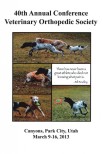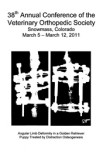Dr. Lascelles completed his bachelor of veterinary science training at the University of Bristol and a surgical residency at the University of Cambridge in the United Kingdom. He is a diplomate of the American and European colleges of veterinary surgeons as well as the Royal college of veterinary surgeons in soft tissue surgery. He completed a PhD at the University of Bristol and a Surgical Oncology fellowship at Colorado State University. Dr. Lascelles is widely regarded as an authority in the area of canine and feline pain management and oncologic surgery. His areas of interest include general orthopedic and soft tissue surgery, with a focus on musculoskeletal neoplasia, maxilo-facial neoplasia and clinical pain management. His current research interests include evaluation of acute and chronic pain and the neurobiology of chronic pain syndromes. He has a particular focus at present on feline joint pain.
Question: The recognition and treatment of pain in small animals has grown in importance over the past 10 years. How would you characterize the current status of pain management in both specialty and general practice?
Answer: Firstly, the recognition of pain has always been an important topic. As a facet of veterinary medicine, however, it has been under emphasized. I consider the current status of pain management to be wide ranging with regards to the level to which pain relief is provided. The field of pain management is constantly shifting, and appears to be moving in a positive direction. It appears that the degree to which pain management is employed ranges from over treatment to obvious under treatment of patients, even in specialty practice. However, I am optimistic about the current status, as it appears that there has been an overall shift in the direction of greater recognition of pain, greater and more appropriate use of analgesics and greater use of non-drug analgesic therapies. This statement is supported by the surveys we have performed regarding attitudes to pain relief and use of analgesics.
Question: What do you consider to be the most exciting or interesting developments in pain management in recent years?
Answer: The most exciting developments in pain management are, firstly, the realization that early treatment in patients with acute and chronic pain can make later treatment more successful. Secondly, the realization that a multimodal approach using a combination of both analgesic drugs and non-drug therapy can optimize pain control. Exciting recent developments have been the discovery that pain control, per se, may, in fact, alter the progression of diseases such as cancer and osteoarthritis.
Question: In addition to clinical duties and research, you also find time to lecture to both private practitioners and board certified specialists. Have you noticed an increased interest and awareness of topics of pain management from general practitioners?
Answer: Very much so. When I go into practices for roundtable discussions, there is a great interest in how to practically apply safe and effective analgesic techniques in the everyday management of patients. Many general practices have adopted the use of multi-drug approaches, and some even multiple-drug constant rate infusions for pain control in the surgical patients. However, one obviously underdeveloped area is the use of local anesthetic techniques including epidurals, joint blocks, local infiltration of surgical wounds and the use of analgesic wound catheters.
Local anesthetics are the only analgesic available that can completely block noxious stimulus transmission from a peripheral area to the central nervous system. They can also be very effective when given systemically, particularly in chronic and neuropathic pain. Local anesthetics are very under used in small animal veterinary medicine.
Local anesthetics can be use in a variety of different ways to provide analgesia both intra and post-operatively.
Topical application
Individual nerve blocks, e.g. intercostal nerve blocks; forelimb nerve block at the elbow; hindlimb nerve blocks; dental and aural nerve blocks
Local infiltration (non-specific) using single or multiple doses (e.g. with wound catheter)
Regional nerve blocks (e.g. Epidural, Spinal, Brachial plexus)
Intra-cavitary (e.g. Intra-articular, Intra-thoracic cavity, Intra-abdominal cavity)
Systemic administration
Question: Have you noticed a better understanding or an improvement in awareness and treatment of pain in residents, interns and fourth year veterinary students?
Answer: It has been both reassuring and encouraging that these individuals do want to know about pain control, not just from the point of view of drug therapies, but also from a holistic perspective. It has become more evident that these young veterinarians and students demonstrate an interest in all aspects of managing pain in their patients. Another encouraging fact is that final-year students are increasingly concerned about pain control and quality of life, and not just treatment of the disease.
Question: Do you think the costs associated with perioperative multimodal pain management are a hurdle for adequate treatment of pain by the private practitioner?
Answer: Approximately 20 to 25 percent of the practitioners that I have talked to on a one to one basis are somewhat concerned with the increased costs associated with a multimodal approach to pain management. The majority of these, however, are concerned with the costs associated with, for example, the application of approved non-steroidal anti-inflammatory medications for perioperative pain control, and often fail to recognize the significant benefits that can be obtained by the appropriate use of local anesthetic agents with little increase in cost to the client.
Question: You have published and lectured widely on the role of non-steroidal anti-inflammatory drugs (NSAIDS) in the treatment of osteoarthritis. In addition to drug therapy, what other modalities do you find useful for the management of the arthritic patient?
Answer: Many different modalities and therapies have been postulated to provide pain relief for chronic pain conditions such as osteoarthritis. The vast majority of these have no evidenced based medicine to behind them. It is important to remember this fact when making choices as to which therapies to recommend. The non-drug therapies that I find to be most effective are weight loss, exercise and physical rehabilitation, diet [joint health diets], glucosamine/chondroitin sulfate supplements [with or without ASU], surgery [joint replacement], acupuncture and massage. My hope is that collaborative efforts will result in evidence based medicine to indicate when and how best to use these modalities to provide relief of chronic pain.
Question: What are the current recommendations regarding the use of selective COX inhibitors and COX/LOX inhibitors for the management of chronic pain?
Answer: These more recent types of non-steroidal drugs appear to be as effective as the non-selective non-steroidals for the management of pain. There may, in some instances, be an increased safety margin associated with these drugs, but the circumstances when this holds true have yet to be clearly defined. The best recommendation for these medications is to use them appropriately, and it is appropriate use that will minimize toxic side effects. This involves both screening patients to determine if risk factors for non-steroidal-associated toxicity are present and then appropriate use with regards to dose, duration of use, patient monitoring and switching between medications. The most important aspect in the use of these medications, however, is the education of clients as to the potential side effects prior to their use.
Question: Many practitioners struggle with pain management strategies for cats, especially those with chronic pain. How does your approach to pain in the feline patient differ from your approach to dogs?
Answer: Firstly, I tend to spend more time assessing pain in feline patients because of the difficulties of not being able to readily assess gait, and the problems in interpreting responses to examination manipulations. For example, cats tend to resent joint extension, even in joints that are normal. I also realize that we need to place a greater emphasis on the owner’s assessment of pain because of the difficulties with assessment of pain in the clinical setting. Secondly, because of the relative lack of approved analgesic drugs in cats, I rely more on non-drug therapies. Interestingly, many non-drug therapies such as nutritional alteration and supplementation appear to be more efficacious in the cat than in the dog. This may be because degenerative joint disease in the cat is a somewhat different disease than in the dog, with the disease in cats having a significant systemic component.
Question: In addition to pain management, you also have an interest in surgical oncology. Do you find that patients with cancer have different requirements for pain management?
Answer: Absolutely. Very often, these patients have been in pain for a period of time prior to presentation and often the degree of pain is relatively intense. This creates substantial changes in sensitivity of the pain transmission system both peripherally and centrally. The result of this is that many of these patients will benefit from drugs given perioperatively that will help to reverse this sensitization such as ketamine, lidocaine, alpha-2-adrenoceptor agonists and opioids. It is also important to remember that in the cancer patients where this sensitization is present, performing painful procedures without optimal perioperative pain control may push them into a state of chronic postoperative or neuropathic pain.
Question: What do you feel is the most exciting development in surgical oncology in recent years?
Answer: Firstly, the interest in surgical oncology as a subspecialty of surgery, and the formation of the Veterinary Society of Surgical Oncology [http://www.vsso.org]. The number of specialty practices and academic institutions offering surgical oncology is a testament to this. Along with this is the growing recognition by veterinarians of the procedures, even those considered radical, that are both possible and that can be tolerated by dogs and cats with an excellent functional outcome. Specifically, from my point of view, I find the advances in maxillofacial surgery to be especially exciting, including radical maxillectomies, radical nosectomies, extensive orbitectomies, mandibulectomies and calvarium resections. On the horizon, I see an increased interest in and development in the area of prostheses following radical oncologic surgery in the small animal patient. Development in this area will not simply be limited to limb prostheses, but will also include chest wall reconstruction and maxillo-facial reconstruction.
Doses for constant rate infusions (CRI’s) in dogs and cats of selected analgesic drugs
| Drug | Dog Dose | Cat Dose | Notes |
| Fentanyl | 2-5 µg/kg loading dose, followed by 2-6 µg/kg/hr (10-30 µg/kg/hr for surgical analgesia) | 1-3 µg/kg loading dose, followed by 2-6 µg/kg/hr (10-30 µg/kg/hr for surgical analgesia) | Appears to result in significant anorexia, especially at higher doses. Can become expensive for larger dogs. Cats do not always ‘look happy’ on this. Cats can become hyperthermic. |
| Hydromorphone | 0.05mg/kg loading dose followed by 0.01-0.02mg/kg/hr CRI | 0.05 mg/kg loading dose followed by 0.005-0.01 mg/kg/hr | Appears very effective in cats, but hyperthermia can be seen |
| Morphine | 0.5mg/kg loading dose followed by 0.1 mg/kg/hr (often need to reduce this when other analgesics are being administered concurrently due to excessive sedation) | 0.2mg/kg loading dose followed by 0.05 mg/kg/hr | Morphine may not be as effective in cats as dogs and humans due to their inability to form an active metabolite. This seems to vary from cat to cat.Avoid in gastrointestinal surgery due to induced stasis |
| Medetomidine | 1-2 µg/kg loading dose followed by 1-2 µg/kg/hr | 1-5 µg/kg loading dose followed by1-5 µg/kg/hr | Probably can be used in mild to moderate heart disease patients, but monitor as the increase in systemic vascular resistance can be significant (however, this effect is greatest initially and decreases with time of administration of the CRI) |
| Ketamine | 0.5mg/kg bolus followed by 10 µg/kg/min intraoperatively, then 0.002 mg/kg/min postoperatively | 0.5mg/kg bolus followed by 10 µg/kg/min intraoperatively, then 0.002 mg/kg/min postoperatively | Small doses are thought to provide analgesia by virtue of NMDA antagonism |
| Lidocaine | 1mg/kg bolus followed by 30 µg/kg/min | Best avoided due to tendency for cardiotoxicity | Provides analgesia (when given in small quantities) probably by interaction with aberrantly expressed sodium channels. Intravenous CRI should not be used with ‘analgesic’ catheters employing the use of local aneshtetics or other intermittent dosing of local anesthetics |
BSc, BVSc, PhD, CertVA, DSAS(ST), DECVS, DACVS
Associate Professor, Small Animal Surgery
Director; Comparative Pain Research Laboratory [http://ncsu.edu/project/cvm-pain/]
Coadministrator; Integrated Pain Management Service
Department of Clinical Sciences
College of Veterinary Medicine
North Carolina State University















